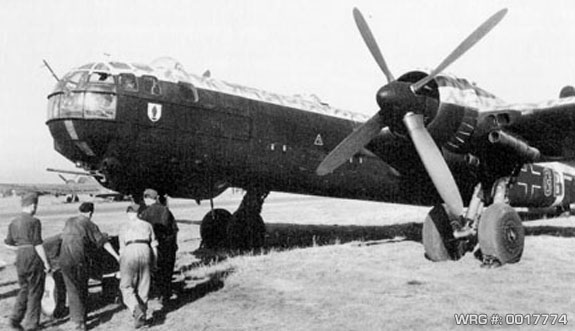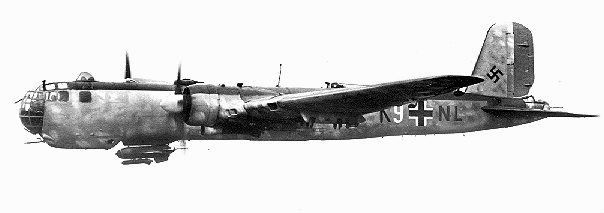These will put you in the mood:


Heres some specs I found
here:
Origin: Ernst Heinkel AG
Sub Contractor: Arado Flugzeugwerke
Type: Six-Seat Heavy Bomber and Missile carrier
Models: A-0 to A-5
First Flight:
V-1: November 19, 1939
A-0: November 1941
Service Delivery:
A-1: March 1942
A-5: February 1943
Engine: 2 Daimler-Benz DB 610A-1/B-1
Thrust: 2,950lb
Note: Each engine comprised of two V12 liquid cooled engines geared to one propeller.
Dimensions:
Span: 31.44m (103 ft. 1ľ in.)
Length: 22m (72 ft. 2 in.)
Height: 6.4m (21 ft.)
Weights: (A-5)
Empty: 37,038lb. (16,800 kg)
Loaded: 68,343lb (31,000kg)
Performance:
Maximum (at 41,000lb.): 295mph (472km/h)
Initial Climb: 853 ft/min (260m/min)
Service Ceiling: 26,500 ft (7080m)
Range with Fritz or Hs 293 missle: 3,107 miles (5000km)
Armament: A-5/R2:
One 7.92mm MG 81J manually aimed in nose
Ammunition: 2000 rounds
One 20mm MG 151 manually aimed in forward ventral gondola
Ammunition: 300 rounds
Two 13mm MG 131 in remote front dorsal turret
Ammunition: 750 rounds per gun
One 13mm MG 131 in electric aft dorsal turret
Ammunition: 750 rounds
One 20mm MG 151 cannon in in tail position
Ammunition: 300 rounds
Bomb Load: A-5/R2:
Sixteen 110 lb. (50kg) SC 50, four 551 lb. (250-kg) SC 250 or two 1,102 lb. (500 kg) SC 500, or two LMA III parachute sea mines, LT 50 torpedos, or Hs 293 of FX 1400 missiles.
Production:
8 Prototypes
35 He 177A-0 (Mainly Arado built)
130 He 177A-1 (Arado built)
170 He 177A-3 (Heinkel Built)
826 He 177A-5
--------------------------------------------------------------------------------
Comments
Arguably the largest bomber built by the Germans, the He 177 suffered many flaws and turned into one of the Luftwaffe's biggest failures (when compare service use to the amount of resources invested.) A significant problem that plagued the program from the beginning was a ludicrous requirement that this extremely large aircraft be capable of dive bombing. This combined with the attempt to reduce drag by coupling the engines, while theoretically sound, proved to be impossible in practice for no aircraft in history had engines that would so readily burst into flame. 75% of the prototypes crashed and a good percentage of the 35 A-0 pre-production airframes were written off in crashed or in-flight fires.
About 700 served on the eastern front using 50mm and 75mm guns for tank-busting while a few brave aircrews ineffectually bombed England.
The He 177 proved to be such a big problem that Goering forbid Heinkel to develope a four engine version (though Heinkel did anyways, the result being the He 277).